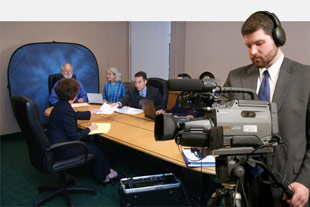Understanding the Value of Legal Videography in Providing Transparent and Legitimate Paperwork for Legal Proceedings
In the world of legal process, the use of lawful videography has become an essential device for making certain openness and credibility in documenting different facets of situations. The advent of technology has transformed exactly how proof exists, supplying a visual story that surpasses traditional written paperwork. Lawful videography not only enhances the precision of recording testaments and events yet also provides a thorough sight that can be crucial in identifying the end result of legal disagreements. As we navigate via the intricacies of contemporary litigation, recognizing the multifaceted relevance of lawful videography becomes vital in supporting the honesty of lawful processes and fostering rely on the pursuit of justice.
Significance of Lawful Videography
Lawful videography plays a critical role in lawful process by giving aesthetic paperwork that improves the accuracy and reputation of testament and proof offered in court. Through the usage of video recordings, attorneys can catch face expressions, body movement, intonation, and other non-verbal hints that might not be fully conveyed through composed records alone. This visual documents assists to provide a much more full and nuanced understanding of the context in which statements were made, aiding judges and courts in their analysis of witness credibility and the weight offered to specific items of evidence.

Boosted Paperwork Accuracy
Given the pivotal function of visual documents in legal proceedings, the emphasis currently shifts to examining exactly how improved documents accuracy accomplished through lawful videography even more strengthens the integrity of the legal system. By providing a visual document that consists of body language, tone of voice, and facial expressions, lawful videography enhances the accuracy of documenting witness testament and court procedures. In essence, improved paperwork precision with legal videography offers as an effective tool for promoting openness and making sure that legal procedures are carried out with the utmost integrity and justness.
Transparency in Legal Proceedings
Openness in lawful process is a basic cornerstone of supporting justice and making certain accountability within the legal system (Legal Videography). By enabling open accessibility to details, procedures, and decisions made during lawful proceedings, openness functions as a safeguard against corruption, bias, and unfair methods. It strengthens public trust fund in the lawful system and enables all celebrations included to believe in the stability of the procedure

Furthermore, openness in lawful process guarantees that all relevant details is disclosed and evaluated, promoting fairness and equal rights before the law. It enables examination of the decision-making procedure and assists determine any kind of prospective mistakes or misbehavior. On the whole, transparency in lawful process is crucial for upholding the concepts of justice, justness, and responsibility.
Reputation Through Video Clip Evidence
Using video proof here in lawful procedures dramatically boosts the trustworthiness of events and testimonies provided to the court. Legal Videography. Video clip evidence captures visual and audio elements that can offer a much more precise representation of what occurred compared to composed documents or verbal testimonies alone. By providing events as they actually occurred, video evidence reduces the possibility of false impression, control, or distortion of facts, hence enhancing the integrity of the details existing
Furthermore, video proof can capture nuanced information such as body movement, faces, intonation, and the series of occasions, which can be essential in establishing the authenticity and integrity of statements. This degree of information can aid judges, courts, and attorneys make even more educated decisions based on concrete aesthetic proof instead than exclusively depending on spoken debates or created accounts that might undergo prejudice or variances.
Fundamentally, making use of video clip evidence in lawful procedures offers to improve trustworthiness, openness, and precision, eventually adding to the trustworthiness of the lawful paperwork and the fairness of the judicial procedure.
Legal Videography in Courtrooms
Legal videography plays an important function in recording and preserving visual proof throughout court room procedures. In modern-day legal practices, making use of video technology has actually become increasingly common in court rooms. Lawful videographers are charged with the duty of taping the process accurately, guaranteeing that all aesthetic elements are documented for future recommendation.
The visibility of legal videography in court rooms boosts transparency and supplies an honest aesthetic record Related Site of the occasions that unravel during tests. Judges, courts, and lawful teams can assess footage to clear up witness statements, evaluate body language, and examine the general behavior of individuals associated with the case. This visual documents can be especially valuable in cases where feelings run use this link high, or testimonies are complicated and call for careful examination.
Moreover, lawful videography in courtrooms can likewise help in the appeals process by giving concrete aesthetic evidence to support or test previous rulings. The in-depth footage captured by legal videographers functions as a dependable resource for attorneys, making certain that justice is offered based on a comprehensive understanding of the realities presented throughout the test.
Final Thought
Finally, lawful videography plays an important function in enhancing paperwork accuracy, advertising transparency in legal proceedings, and boosting trustworthiness with video clip proof (Legal Videography). By giving aesthetic documents of occasions, legal videography makes sure that all parties involved have access to the very same info, inevitably adding to a simply lawful and reasonable system. Its existence in courts better strengthens its relevance in offering transparent and trustworthy documentation for legal proceedings
In the world of lawful process, the use of lawful videography has arised as a critical device for guaranteeing transparency and credibility in recording different aspects of cases.Legal videography plays an essential duty in lawful process by providing aesthetic documentation that enhances the precision and trustworthiness of testament and proof provided in court.Given the pivotal function of aesthetic documentation in legal process, the focus currently moves to analyzing exactly how improved documentation precision accomplished with lawful videography further enhances the honesty of the lawful system.In the context of lawful videography, openness is even more boosted by supplying a exact and unaltered aesthetic record of events as they unravel during lawful procedures.In conclusion, lawful videography plays an important duty in boosting documentation precision, promoting transparency in lawful process, and raising reputation via video clip proof.